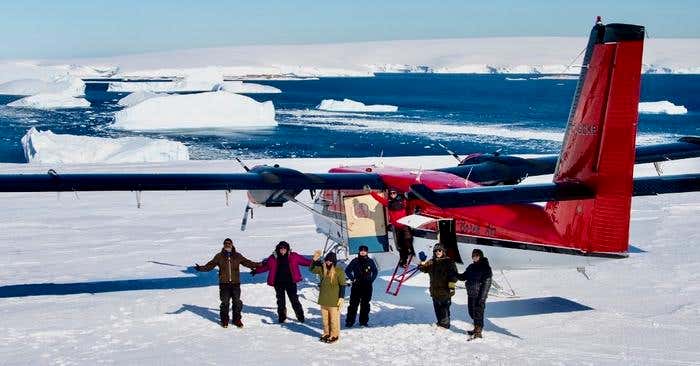Study reveals link between global warming and rising sea levels
Study reveals natural forces could substantially reduce Antarctica’s impact on rising sea levels, but only if carbon emissions are swiftly reduced in the coming decades.

The ANET-POLENET team flew to remote field sites on Antarctica’s Backer Islands to record bedrock uplift. Ohio State University co-author Terry Wilson is second from the left. (CREDIT: Nicolas Bayou)
Earth's natural forces might significantly limit Antarctica’s role in rising sea levels—if carbon emissions are sharply reduced in the near future. However, if emissions continue unchecked, the loss of Antarctic ice could contribute even more to sea level rise than scientists had previously estimated.
This dual possibility underscores the importance of understanding how Antarctica’s massive ice sheet, the largest on the planet, might respond to ongoing climate change.
Lead author Natalya Gomez, an Associate Professor in McGill’s Department of Earth and Planetary Sciences and Canada Research Chair in Ice Sheet-Sea Level Interactions, emphasizes the stakes: “With nearly 700 million people living in coastal areas and the potential cost of sea-level rise reaching trillions of dollars by the end of the century, understanding the domino effect of Antarctic ice melt is crucial.”
The study, led by McGill University, delves into the interaction between the Antarctic Ice Sheet and the earth beneath it, a dynamic that hinges heavily on carbon-emission levels. Previous research has not thoroughly explored this complex relationship, making the study’s findings especially critical.
Gomez and her team’s research reveals a stark reality: while some degree of sea level rise is inevitable, swift and decisive action to reduce emissions could mitigate some of the most devastating effects of climate change, particularly for vulnerable coastal communities.
When Antarctic ice melts, the pressure on the land beneath it decreases, allowing the land to rise—a phenomenon known as post-glacial uplift. This process can act as both a blessing and a curse. If global warming is limited by reducing emissions, this uplift can serve as a natural brake, slowing the flow of ice from land to sea. The study found that this effect could reduce Antarctica’s contribution to sea level rise by as much as 40 percent.
Related Stories
On the other hand, if carbon emissions continue at their current rate, the rapid warming of the planet will outpace the uplift’s ability to slow ice loss. In such a scenario, the rebounding land will push more ocean water away from Antarctica, exacerbating sea level rise along coastlines where millions of people live.
To arrive at these conclusions, Gomez collaborated with researchers from Canada and the United States to develop a three-dimensional model of Earth’s interior. This model was based on geophysical field measurements from the U.S. ANET-POLENET project, which deployed sensitive instruments across vast areas of Antarctica to record bedrock uplift and seismic activity. These extensive measurements were crucial for accurately capturing the variations in the Antarctic mantle, a critical factor in the study.
Maryam Yousefi, a geodesist at Natural Resources Canada and a co-author of the study, explained, “Our 3-D model peels back Earth’s layers like an onion, revealing dramatic variations in thickness and consistency of the mantle below. This knowledge helps us better predict how different areas will respond to melting.” Yousefi, who previously held positions as a Postdoctoral Fellow at McGill and Penn State universities, noted that this is the first model to capture the relationship between Antarctica's ice and the underlying earth in such detail.
Rob DeConto, a co-author and glaciologist at the University of Massachusetts, pointed out the broader implications of the study, stating, “This study marks a breakthrough in our ability to better predict the impacts of climate change on rising seas and to inform effective environmental policy.”
The study’s findings, published in Science Advances, also highlight the deep inequalities of climate change. Island nations, which contribute the least to global carbon emissions, are among those most vulnerable to the consequences, particularly in terms of rising sea levels.
This research is a collaborative effort involving scholars from McGill, Pennsylvania State, Cambridge, Columbia, Colorado State, Ohio State, the University of Massachusetts Amherst, the University of Washington, and the Union of Concerned Scientists. Funding for the study was provided by the Canadian Natural Sciences and Engineering Research Council, the U.S. National Science Foundation, and the Canada Research Chairs program.
The implications of this research extend beyond the scientific community, offering critical insights for policymakers, particularly those concerned with coastal infrastructure and climate adaptation strategies. As the global community grapples with the realities of climate change, studies like this underscore the urgent need for action to reduce emissions and protect vulnerable populations from the escalating threats posed by rising seas.
Note: Materials provided above by The Brighter Side of News. Content may be edited for style and length.
Like these kind of feel good stories? Get The Brighter Side of News' newsletter.



